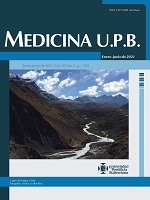Experiencias psicóticas e ideación suicida en adolescentes
Contenido principal del artículo
Resumen
Objetivo: Determinar la asociación entre experiencias psicóticas y trastornos mentales no psicóticos en población general. Metodología: Estudio de prevalencia analítico con fuente de información secundaria en población general de 15 a 65 años seleccionados de modo aleatorio por muestreo probabilístico. El instrumento de recolección de la información fue el CIDI (por su sigla en inglés), que realiza diagnóstico de 23 trastornos mentales según criterios DSM-IV (por su sigla en inglés). Se evaluaron variables sociodemográficas, clínicas psiquiátricas y seis experiencias psicóticas (alucinaciones e ideas delirantes) como variable principal. El estudio primario fue aprobado por el Comité de Investigación y de Ética Universitario. Se consideró significancia estadística valor de p<0.05. Se calcularon como medidas de asociación OR con su IC95%. Resultados: Se evaluaron 2 072 personas, el 1.85% presentó experiencias psicóticas, de los cuales el 53.3 % eran mujeres, y el 44.4 %, adolescentes. Hubo asociación entre experiencias psicóticas e ideación suicida (OR 3.51, IC95% 1.49-8.29]), ser adolescente (OR 2.29, IC95% 1.24-4.22]) y pertenecer al régimen contributivo de salud (OR 0.34, IC95% 0.18-0.63). Conclusiones: Los jóvenes y aquellas personas con ideación suicida tuvieron mayor probabilidad de reportar experiencias psicóticas. Dentro del intento global por comprender mejor para actuar de forma más efectiva frente al comportamiento suicida especialmente en la población más joven, una mejor comprensión del papel que desempeñan las experiencias psicóticas (EP) puede ser de ayuda.
Referencias
Gaebel W, Zielasek J. Focus on psychosis. Dialogues Clin Neurosci 2015;17:9-18.
Lieberman JA, First MB. Psychotic disorders. N Engl J Med 2018;379:270-80.
Gore FM, Bloem PJN, Patton GC, Ferguson J, Joseph V, Coffey C, et al. Global burden of disease inyoung people aged 10-24 years: a systematic analysis. Lancet 2011;377:2093-102.
Fonseca Pedrero E, Debbané M. Schizotypal traits and psychotic-like experiences during adolescence: an update. Psicothema 2017;29:5-17.
Linscott RJ, van Os J. Systematic reviews of categorical versus continuum models in psychosis: evidence for discontinuous subpopulations underlying a psychometric continuum. Implications for DSM-V, DSM-VI, and DSM-VII. Annu Rev Clin Psychol 2010;6:391-419.
Dominguez MG, Saka MC, can Saka M, Lieb R, Wittchen HU, van Os J. Early expression of negative/disorganized symptoms predicting psychotic experiences and subsequent clinical psychosis: a 10-year study. Am J Psychiatry 2010;167:1075-82.
Krabbendam L, Myin-Germeys I, Hanssen M, de Graaf R, Vollebergh W, Bak M, et al. Development of depressed mood predicts onset of psychotic disorder in individuals who report hallucinatory experiences. Br J Clin Psychol 2005;44:113-25.
Van Rossum I, Dominguez MG, Lieb R, Wittchen HU, van Os J. Affective dysregulation and reality distortion: a 10-year prospective study of their association and clinical relevance. Schizophr Bull 2011;37:561-71.
Smeets F, Lataster T, Dominguez MG, Hommes J, Lieb R, Wittchen HU, et al. Evidence that onset of psychosis in the population reflects early hallucinatory experiences that through environmental risks and affective dysregulation become complicated by delusions. Schizophr Bull 2012;38:531-42.
Yung AR, Lin A. Psychotic experiences and their significance. World Psychiatry 2016;15:130-1.
Pedrero EF, Giráldez SL, Piñeiro M de las MP, García UV, Baigrie SS, Fernández JM. Experiencias psicóticas atenuadas en población adolescente. Papeles del Psicólogo 2009;30:63-73.
Linscott RJ, van Os J. An updated and conservative systematic review and meta-analysis of epidemiological evidence on psychotic experiences in children and adults: on the pathway from proneness to persistence to dimensional expression across mental disorders. Psychol Med 2013;43:1133-49.
McGrath JJ, Saha S, Al-Hamzawi A, Alonso J, Bromet EJ, Bruffaerts R, et al. Psychotic experiences in the general population: a cross-national analysis based on 31 261 Respondents from 18 countries. JAMA Psychiatry 2015;72:697.
Kırlı U, Binbay T, Drukker M, Elbi H, Kayahan B, Keskin Gökçelli D, et al. DSM outcomes of psychotic experiences and associated risk factors: 6-year follow-up study in a community-based sample. Psychol Med 2018;1-11.
Armando M, Nelson B, Yung AR, Ross M, Birchwood M, Girardi P, et al. Psychotic-like experiences and correlation with distress and depressive symptoms in a community sample of adolescents and young adults. Schizophr Res 2010;119:258-65.
Torres Y, editor. Primer estudio poblacional de salud mental, 2011-2012. Medellín: Editorial CES; 2012.
Varghese D, Scott J, Welham J, Bor W, Najman J, O’Callaghan M, et al. Psychotic-like experiences in major depression and anxiety disorders: a population-based survey in young adults. Schizophr Bull 2011;37:389-93.
Van Os J, Reininghaus U. Psychosis as a transdiagnostic and extended phenotype in the general population. World Psychiatry 2016;15:118-24.
Bromet EJ, Nock MK, Saha S, Lim CCW, Aguilar-Gaxiola S, Al-Hamzawi A, et al. Association between psychotic experiences and subsequent suicidal thoughts and behaviors: a cross-national analysis from the World Health Organization World Mental Health Surveys. JAMA Psychiatry 2017;74:1136-44.
Honings S, Drukker M, Groen R, van Os J. Psychotic experiences and risk of self-injurious behaviour in the general population: a systematic review and meta-analysis. Psychol Med 2016;46:237-51.
DeVylder JE, Lukens EP, Link BG, Lieberman JA. Suicidal ideation and suicide attempts among adults with psychotic experiences: data from the Collaborative Psychiatric Epidemiology Surveys. JAMA Psychiatry 2015;72:219-25.
Pain O, Dudbridge F, Cardno AG, Freeman D, Lu Y, Lundstrom S, et al. Genome-wide analysis of adolescent psychotic-like experiences shows genetic overlap with psychiatric disorders. Am J Med Genet Part B Neuropsychiatr Genet 2018;177:416-25.
Kelleher I, Corcoran P, Keeley H, Wigman JTW, Devlin N, Ramsay H, et al. Psychotic symptoms and population risk for suicide attempt: a prospective cohort study. JAMA Psychiatry 2013;70:940-8.
Van Os J, Linscott RJ, Myin-Germeys I, Delespaul P, Krabbendam L. A systematic review and metaanalysis of the psychosis continuum: evidence for a psychosis proneness-persistence-impairment model of psychotic disorder. Psychol Med 2009;39:179-95.
Gaines AD. Culture-specific delusions: sense and nonsense in cultural context. Psychiatr Clin North Am 1995;18:281-301.
Loch AA, Chianca C, Alves TM, Freitas EL, Hortêncio L, Andrade JC, et al. Poverty, low education, and the expression of psychotic-like experiences in the general population of São Paulo, Brazil. Psychiatry Res 2017;253:182-8.


